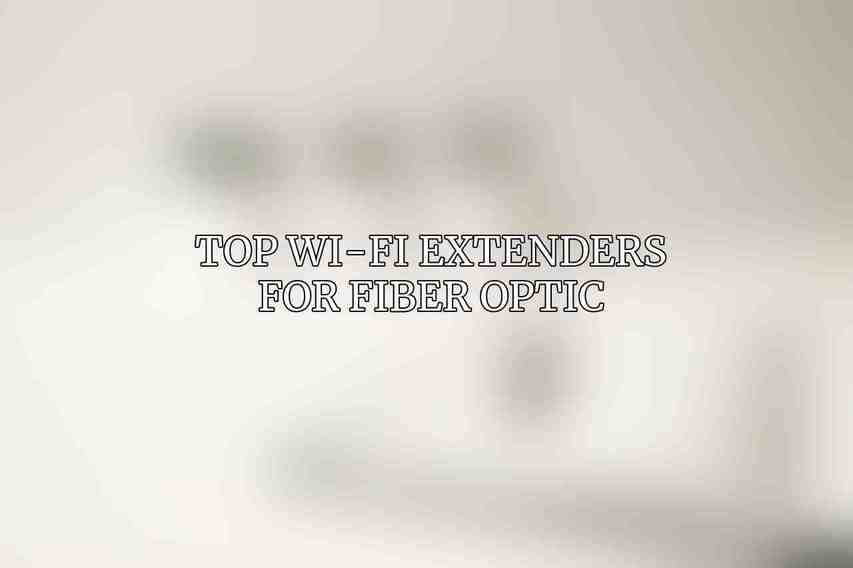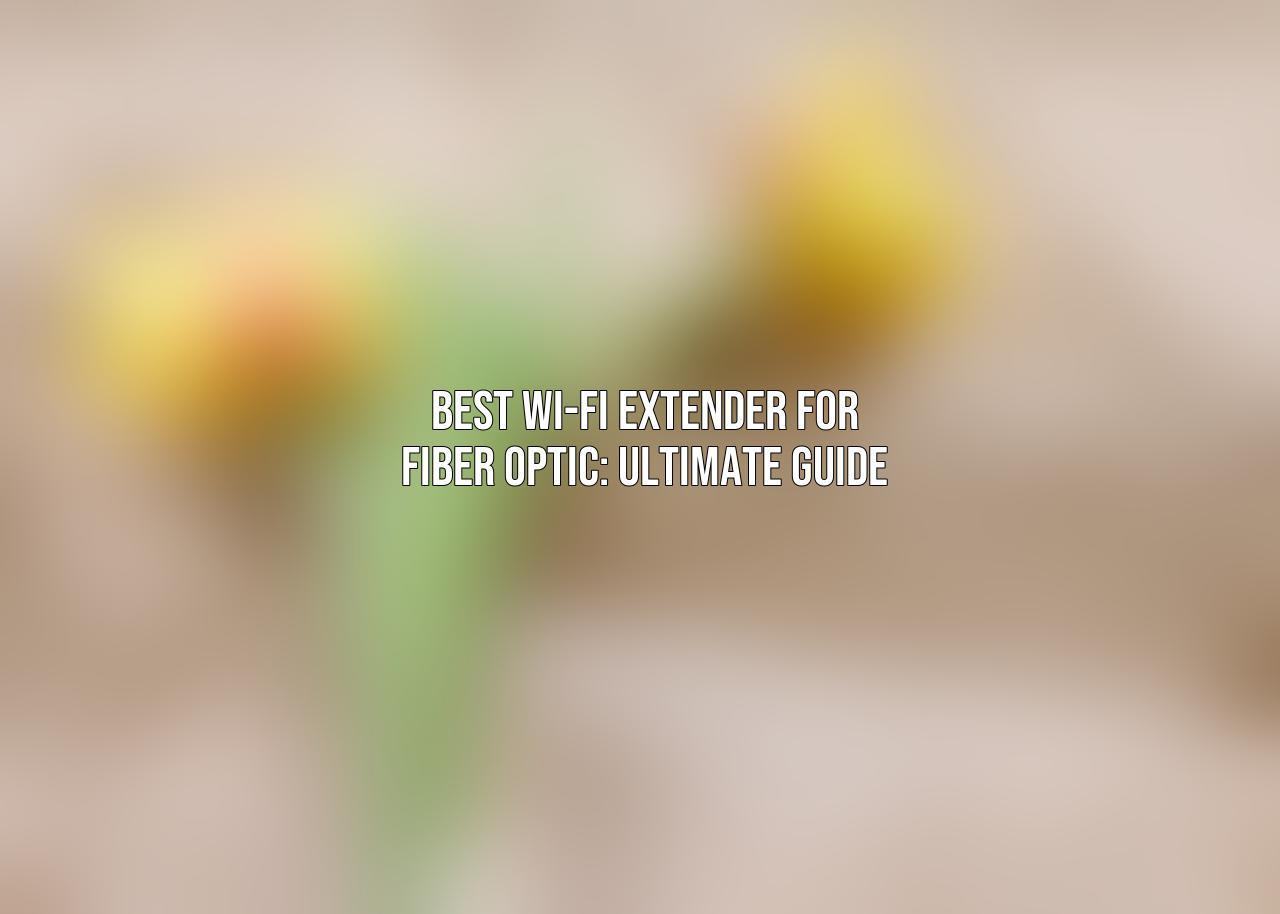Fiber optic internet has revolutionized the way we connect and interact online, offering unparalleled speeds, minimal latency, and reliable connectivity. The transmission of data through thin glass fibers enables swift and efficient internet access, ideal for streaming, gaming, remote work, and more. However, even with the power of fiber optic, Wi-Fi signals can sometimes struggle to reach every corner of a home, especially in larger spaces or areas with obstacles that impede signal strength.
Wi-Fi extenders play a crucial role in maximizing the benefits of fiber optic internet by amplifying and extending the wireless signal coverage. Choosing the right Wi-Fi extender is essential to ensure seamless connectivity throughout your home or office space. Factors such as speed, range, compatibility, and features should be carefully considered to complement your high-speed fiber optic connection effectively. In this comprehensive guide, we will explore the top Wi-Fi extenders specifically tailored for fiber optic users, highlighting their key features and benefits to help you make an informed decision.
| Wi-Fi Extenders | Key Features | Pros | Cons | Price |
|---|---|---|---|---|
| TP-Link RE605X Wi-Fi 6 Range Extender (https://amazon.com/s?k=TP-Link+RE605X+Wi-Fi+6+Range+Extender) | Wi-Fi 6, Gigabit Ethernet port, OneMesh support, Parental controls | Fast speeds, wide coverage, good for gaming and streaming | Can be expensive | $100-$150 |
| Netgear Nighthawk X6S EX8000 Wi-Fi Extender (https://amazon.com/s?k=Netgear+Nighthawk+X6S+EX8000+Wi-Fi+Extender) | Wi-Fi 6, Dual-band, MU-MIMO, Gigabit Ethernet port | Powerful performance, wide coverage, good for large homes | Can be expensive | $150-$200 |
| Linksys RE7000 MAX-STREAM AC1900 Wi-Fi Range Extender (https://amazon.com/s?k=Linksys+RE7000+MAX-STREAM+AC1900+Wi-Fi+Range+Extender) | Dual-band, Gigabit Ethernet port, MU-MIMO, Beamforming | Good performance, affordable, easy to use | Not as powerful as some others | $70-$100 |
| TP-Link RE305 Wi-Fi Range Extender (https://amazon.com/s?k=TP-Link+RE305+Wi-Fi+Range+Extender) | Dual-band, Gigabit Ethernet port, Compact design | Affordable, easy to use, good for small to medium-sized homes | Not as powerful as some others | $30-$50 |
| Netgear Orbi WiFi 6E Tri-Band Mesh WiFi System (https://amazon.com/s?k=Netgear+Orbi+WiFi+6E+Tri-Band+Mesh+WiFi+System) | Wi-Fi 6E, Tri-band, Gigabit Ethernet ports, Whole-home coverage | Fastest speeds, widest coverage, best for large homes | Can be very expensive | $300-$500 |
Quick List :
- 1. NETGEAR Orbi WiFi 6E:
- 2. Installation and Setup:
Top Wi-Fi Extenders for Fiber Optic

TP-Link RE605X AC1900 Wi-Fi Range Extender
When it comes to speed and performance, the TP-Link RE605X AC1900 Wi-Fi Range Extender shines with its dual-band AC1900 Wi-Fi capability, offering up to 1300 Mbps on the 5 GHz band and 600 Mbps on the 2.4 GHz band. With a commendable coverage of 3,000 square feet, this extender is suitable for larger homes seeking reliable connectivity. Additionally, its compatibility with all popular Wi-Fi routers and devices ensures a seamless integration into your existing network setup. The OneMesh support enables effortless roaming, while the Gigabit Ethernet port allows for wired connections, making it a versatile choice for fiber optic users.
Netgear Nighthawk X4S EX7300
Another noteworthy contender is the Netgear Nighthawk X4S EX7300, offering AC2200 dual-band Wi-Fi speeds of up to 1625 Mbps on the 5 GHz band and 600 Mbps on the 2.4 GHz band. With coverage extending up to 2,500 square feet, this extender provides a reliable signal even in larger spaces. Its compatibility with various Wi-Fi standards, including 802.11ac, 802.11n, and 802.11g, ensures seamless integration with a wide range of devices. The inclusion of four Gigabit Ethernet ports, MU-MIMO technology, and advanced security features enhances the overall user experience, making it a solid choice for fiber optic users seeking high-performance Wi-Fi extension.
Linksys RE7000 MAX-STREAM AC1900+ Wi-Fi Range Extender
The Linksys RE7000 MAX-STREAM AC1900+ Wi-Fi Range Extender offers AC1900 dual-band Wi-Fi speeds, reaching up to 1300 Mbps on the 5 GHz band and 600 Mbps on the 2.4 GHz band. With a coverage expansion of up to 2,000 square feet, this extender is perfect for medium to large homes. Its compatibility with various routers and devices ensures a hassle-free setup process, while the Gigabit Ethernet port and beamforming technology optimize signal transmission for enhanced connectivity. The support for WPS setup further simplifies the connection process, making it a user-friendly choice for fiber optic users.
D-Link DAP-1660 AC1300 Wi-Fi Range Extender
For those seeking a compact yet powerful Wi-Fi extender, the D-Link DAP-1660 AC1300 offers dual-band Wi-Fi speeds of up to 867 Mbps on the 5 GHz band and 400 Mbps on the 2.4 GHz band. With a coverage range of up to 1,500 square feet, this extender is ideal for smaller to medium-sized homes. Its compatibility with 802.11ac, 802.11n, and 802.11g standards ensures broad device compatibility. The inclusion of a Gigabit Ethernet port and a WPS button for quick setup adds to its convenience, making it a reliable choice for enhancing Wi-Fi coverage in fiber optic setups.
NETGEAR Orbi WiFi 6E
While not a standalone extender, the NETGEAR Orbi WiFi 6E stands out as a whole-home mesh system that offers exceptional Wi-Fi 6E performance with speeds reaching up to 6000 Mbps. With wide coverage suitable for multi-level homes and seamless roaming capabilities, this system ensures reliable connectivity throughout your space. Its support for the latest Wi-Fi 6E standard guarantees compatibility with future devices, while the tri-band design and advanced security features further enhance the user experience. The user-friendly app for management simplifies network monitoring and control, providing a comprehensive solution for fiber optic users seeking top-of-the-line performance.
Factors to Consider When Choosing a Wi-Fi Extender
When selecting a Wi-Fi extender to complement your fiber optic internet connection, several key factors should be taken into account:
- Speed and Bandwidth: Ensure that the extender’s speed matches or exceeds your fiber optic connection speed to maximize performance.
- Range and Coverage: Consider the size of your space and any obstacles that may impact signal strength to ensure optimal coverage.
- Compatibility: Verify that the extender is compatible with your existing router and devices for seamless integration.
- Features: Explore additional features such as Gigabit Ethernet ports, MU-MIMO technology, and advanced security protocols to enhance your connectivity experience.
- Ease of Use and Setup: Opt for an extender with a user-friendly setup process and intuitive management options for hassle-free operation.
- Budget: Determine a suitable budget range and find a high-quality extender that meets your connectivity needs without compromising on performance.
Installation and Setup
To optimize the performance of your chosen Wi-Fi extender, follow these steps for installation and setup:
- Choosing the Right Location: Position the extender strategically to ensure optimal signal distribution throughout your space.
- Connecting the Extender to Your Router: Follow the manufacturer’s instructions to establish a seamless connection between the extender and your main router.
- Configuring the Extender: Set up network names, passwords, and any other relevant settings to customize your extended Wi-Fi network according to your preferences.
Stay tuned for the next section where we will delve into troubleshooting common issues and optimizing the performance of your Wi-Fi extender.
Read more on Best Wi-Fi Extender for Security Cameras: Best Reviews
More on Best Wi-Fi Extenders:Wi-Fi Extenders
Frequently Asked Questions
What is the best Wi-Fi extender for fiber optic connections?
The best Wi-Fi extender for fiber optic connections is typically one that supports the latest Wi-Fi standards such as 802.11ac or 802.11ax. Some recommended options include the TP-Link Deco X20, Netgear Nighthawk AX8, and Asus RT-AX88U.
How does a Wi-Fi extender improve the internet speed in a fiber optic network?
A Wi-Fi extender works by receiving your existing Wi-Fi signal, amplifying it, and then transmitting the boosted signal. This helps to eliminate dead spots and ensure a strong Wi-Fi connection throughout your home, ultimately improving internet speed in a fiber optic network.
Can I use any Wi-Fi extender with my fiber optic internet connection?
While most Wi-Fi extenders are compatible with fiber optic internet connections, it’s important to check the specifications of the extender to ensure compatibility. Look for extenders that support the same Wi-Fi standards as your fiber optic router for optimal performance.
Do I need a Wi-Fi extender if I have fiber optic internet?
While fiber optic internet is known for its high speeds and reliability, you may still benefit from a Wi-Fi extender if you have dead spots or weak Wi-Fi signals in certain areas of your home. A Wi-Fi extender can help ensure consistent coverage and speeds throughout your space.
How can I set up a Wi-Fi extender for my fiber optic network?
Setting up a Wi-Fi extender for your fiber optic network typically involves connecting the extender to your existing Wi-Fi network and following the manufacturer’s instructions for configuration. This may include using a mobile app or accessing a web interface to customize settings.

